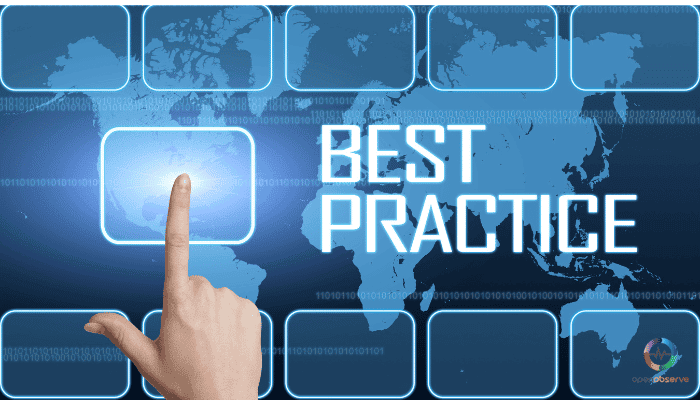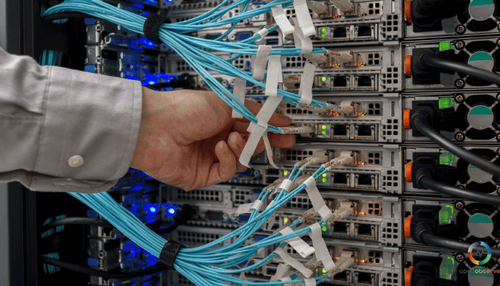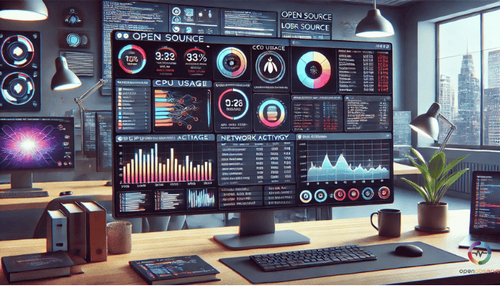
Observability best practices are vital for enabling IT teams to gain deeper insights into the behavior of their systems, from identifying bottlenecks to resolving issues before they escalate. Observability enables a more holistic, data-driven approach to understanding the internal states of your applications, unlike traditional monitoring, which focuses on predefined metrics.
For modern DevOps teams, implementing observability best practices means not only tracking logs, metrics, and traces but also creating proactive feedback loops that ensure continuous improvement.
This guide explores the top observability best practices that every organization should implement to build resilient, scalable, and high-performing systems.
Understanding Observability
Observability is the practice of understanding a system's internal state. To examine the Key Components of Observability and explain them, one examines its external outputs, such as logs, metrics, and traces.
It goes beyond traditional monitoring by allowing IT teams to understand why a system behaves the way it does, not just what is happening.
In today’s complex, distributed systems, quicker issue detection, real-time response, and proactive improvements become possible with observability.
Difference Between Observability and Monitoring
It’s easy to confuse observability with monitoring, but they serve distinct roles.
Monitoring tracks predefined metrics and sends alerts when certain thresholds are exceeded. It's reactive by nature, letting you know when something has gone wrong.
Observability, on the other hand, is proactive. It allows you to investigate and troubleshoot issues you didn’t foresee by gathering comprehensive data on system performance, regardless of whether an alert was triggered.
Implementing observability best practices allows teams to gain a deeper understanding of their systems, ultimately improving reliability and performance.
Next, we’ll dive into the Key Components of Observability, where we'll break down how logs, metrics, and traces contribute to a complete observability strategy.
Key Components of Observability
Observability relies on three primary components to provide complete visibility into system health: logs, metrics, and traces. Each plays a vital role in delivering insight into application performance and stability.
They enable teams to see what’s happening, why it’s happening, and how to resolve issues before these affect the user experience.
Logs
Logs capture detailed records of events that occur within your system. They serve as an audit trail, helping you trace the origin of issues and assess how system behavior has evolved over time.
Logs are usually unstructured, allowing more data collection flexibility, but require robust tools to parse and analyze.
OpenObserve excels here by ingesting and analyzing logs in real-time, allowing IT teams to quickly query and make sense of log data to pinpoint critical issues.
Metrics
Metrics provide quantifiable measurements that describe the performance of different aspects of your system, such as CPU usage, request rates, or memory consumption.
Unlike logs, metrics are structured and generally easier to analyze, making them perfect for monitoring real-time performance trends.
With OpenObserve’s integrated dashboards, you can visualize and monitor these metrics over time, making it easier to spot patterns and predict potential bottlenecks before they happen.
Traces
Traces capture the path a request takes through a distributed system. They allow you to see how services interact and where bottlenecks or failures occur. By tracing the flow of requests across multiple services, you can pinpoint latency issues or misconfigurations.
OpenObserve consolidates tracing data alongside logs and metrics, offering a unified view of system performance. This integration allows for deeper visibility and quicker response times when detecting and resolving issues.
With logs, metrics, and traces working together, observability best practices can indeed be implemented, ensuring comprehensive insight into system health.
To take full advantage of OpenObserve’s capabilities in consolidating tracing data, logs, and metrics for a unified view of your system’s performance, sign up for OpenObserve today. For further insights into how OpenObserve can transform your observability strategy, visit our website.
Next, we’ll explore the 10 Observability Best Practices every organization should follow for optimized performance.
Read more about Navigating Observability: Logs, Metrics, and Traces Explained
10 Observability Best Practices
Implementing observability best practices ensures that you can maintain your systems' health, performance, and reliability.
Below are key strategies that every organization should follow to achieve effective observability.
1. Know Your Platform
Understanding the ins and outs of your platform is critical for building a robust observability stack.
You need to know how your systems interact, where potential bottlenecks lie, and what components are crucial to monitor. Having a deep knowledge of your infrastructure will guide you in choosing the right tools and setting the right metrics.
2. Monitor What’s Important
Not all metrics are created equal. Focus on monitoring the most impactful metrics for your application or service. Monitoring key indicators like CPU usage, memory consumption, and request rates helps you stay on top of issues before they escalate.
Prioritizing what’s essential ensures that your observability efforts provide real value.
3. Put Alerts Only for Critical Events
Flooding your team with alerts for non-critical events dilutes their attention. Focus on setting alerts only for critical metrics that require immediate action.
Refining your alert strategy ensures that your team reacts only when necessary, increasing overall efficiency and reducing alert fatigue.
4. Create a Standardized Data Logging Format
A standardized data logging format helps streamline log management and analysis. When logs follow a consistent structure, it’s easier to extract meaningful insights and troubleshoot issues.
This practice simplifies integration with other observability tools, ensuring your logs can be aggregated, parsed, and understood quickly.
5. Store Logs Giving Insights About Critical Events
Logging isn’t just about collecting data—it's about capturing the correct information. Ensure your logs provide clear insights into critical events, such as system failures or unusual behavior.
Storing these logs efficiently allows your team to quickly access and analyze them during an incident.
6. Ensure Data Can Be Aggregated and Centralized
Centralizing your data is crucial for real-time insights and comprehensive analysis. Tools like OpenObserve make this easy by aggregating logs, metrics, and traces from multiple sources.
OpenObserve handles large-scale data aggregation across different infrastructure types—servers, containers, and databases—ensuring that organizations of all sizes can scale seamlessly.
7. Don’t Rely on Default Dashboards
Default dashboards may give a surface-level view of your system, but they rarely provide the detailed insights you need.
OpenObserve offers customizable dashboards, allowing you to tailor your visualizations to your organization’s unique needs. This flexibility enables teams to create focused views that track the most important metrics, traces, and logs.
8. Leverage Integrations
To create a holistic observability system, it’s essential to integrate your observability tools with other platforms and services in your infrastructure.
This integration ensures data flows smoothly between different tools and systems, providing a complete view of your application’s health.
9. Integrate with Automated Remediation Systems
Integrating observability with automated remediation systems allows you to act on problems in real time.
When an alert triggers, automated systems can apply predefined fixes, reducing downtime and improving application reliability.
10. Effective Feedback Loops
A strong feedback loop ensures that insights gained from observability inform future optimizations and decisions.
Continuously analyzing performance metrics and sharing them across teams enables you to refine your system and improve resilience over time.
By following these observability best practices, organizations can ensure peak performance and quick issue resolution. In the next section, we’ll explore practical strategies for implementing these best practices.
Read more on Best Practices for Web Application Performance Monitoring Tools
Implementation Strategies
A strong observability framework requires more than just the right tools—clear objectives, team collaboration, and structured approaches are essential.
Below are the key strategies to ensure successful implementation.
1. Setting Clear Objectives and Goals
Before diving into the specifics, it’s essential to know what you’re aiming to achieve.
Define what "success" looks like for your observability strategy.
Are you focused on improving uptime, speeding up issue resolution, or enhancing system performance?
Having measurable goals helps you gauge the effectiveness of the observability system and adapt as necessary.
Key Tip: Start by identifying the most critical components of your infrastructure and prioritize observability around those.
2. Fostering Collaboration Across Teams
Observability is not just for the DevOps or operations teams—it's a collaborative effort. Cross-functional teams, including developers, testers, and even business units, must share insights.
This collaboration ensures a holistic view of your system’s health and performance, facilitating quicker responses to issues.
Key Tip: Promote transparency by setting up shared dashboards and automated alerts accessible to all stakeholders.
3. Consistent Instrumentation of Applications and Infrastructure
Instrumentation is the backbone of observability. Ensure that all key systems, applications, and infrastructure components are consistently instrumented to collect accurate and relevant metrics, logs, and traces.
Collecting data consistently provides a unified view of system performance and reliability.
Key Tip: Use automated tools to help streamline the instrumentation process across multiple environments.
4. Defining KPIs and Setting Alert Thresholds
To avoid noise and alert fatigue, define Key Performance Indicators (KPIs) that matter to your specific business goals. Not every metric needs a response, but those that indicate performance or availability issues must trigger an alert.
Define clear thresholds for when alerts should be triggered so teams can respond effectively.
Key Tip: Tailor alerts to different team members based on the relevance and severity of the issue, ensuring that only actionable alerts are sent.
5. Creating Comprehensive Dashboards for Visibility
Dashboards are essential for visualizing system health in real-time. Make sure to customize dashboards according to the needs of your teams—what’s important for one team may not be for another.
Rather than relying on default setups, tailor dashboards for specific KPIs, logs, and traces.
Key Tip: Use a tool like OpenObserve to create customizable, real-time dashboards that offer centralized visibility of logs, metrics, and traces across different systems.
Sign up for OpenObserve today and start managing your data like never before.
These strategies provide a solid foundation for implementing observability best practices and ensuring your infrastructure remains resilient.
Read more on Unifying Observability and Troubleshooting: The Power of Observability Dashboards
Data Collection and Telemetry
When managing observability, data collection plays a crucial role in delivering meaningful insights, but it's important to strike a balance. Gathering too much data can lead to inefficiency, noise, and excessive costs.
Let's break down some best practices for collecting telemetry data efficiently.
1. Avoiding Excessive Data Collection
One of the most common pitfalls is collecting too much data, which leads to bloated systems and hard-to-analyze results. While it's tempting to monitor everything, a strategic approach to data collection can save resources and deliver more valuable insights.
For example, if you’re collecting detailed telemetry data across multiple systems, start by identifying the business-critical metrics. Collect data that directly influences operational decisions or reflects key performance indicators.
Tools like OpenObserve offer advanced filtering options that help avoid information overload by ensuring that only meaningful and actionable data is stored and analyzed. This helps reduce unnecessary data and focus on key metrics.
2. Business-Specific Metric Selection
Choosing business-specific metrics ensures that the collected data aligns with your organization’s goals. These metrics vary from company to company but should always reflect what drives value—whether it’s application response times, error rates, or infrastructure performance.
OpenObserve provides flexible options to filter, process, and display business-specific metrics, which ensures that you’re not overwhelmed with unnecessary data. By focusing on what's critical to your business, you can gain deeper insights and make informed decisions quickly.
3. Importance of Telemetry Data Across Workload Tiers
To achieve complete observability, you need to monitor telemetry data across all tiers of your workloads—front-end, back-end, infrastructure, and everything in between. This holistic view ensures that issues are identified quickly and performance bottlenecks can be resolved before they impact the user experience.
OpenObserve’s ability to ingest telemetry data from various sources across workload tiers makes it a powerful platform for centralizing this information. This unified view helps detect system-wide issues and optimizes performance across the entire stack.
To explore how OpenObserve can centralize telemetry data across all your workloads and help optimize your system's performance, visit the OpenObserve website.
Read more on Difference Between Monitoring and Observability Explained
Cost Management and Visualization
When it comes to observability, cost management plays a crucial role in ensuring that monitoring tools don’t become an overwhelming financial burden.
Implementing observability best practices means balancing comprehensive data collection with affordability, especially for organizations aiming for long-term sustainability.
1. Monitoring Observability Tool Costs
Monitoring tools often incur hidden costs, especially when data collection, storage, and visualization scale up. For teams managing complex systems, keeping track of these costs can prevent budget overruns.
It's important to track not only the volume of data collected but also how efficiently it’s being processed.
OpenObserve stands out here as an affordable alternative, offering powerful data visualization and observability features without the steep costs associated with many enterprise-level tools.
Its efficient design ensures that even organizations with limited budgets can implement full observability without compromising on essential features like data retention or complex querying.
Join our growing community of developers and contributors. Check out our GitHub repository for resources, documentation, and the latest updates.
2. Service Level Indicators (SLIs), Service Level Objectives (SLOs), and Service Level Agreements (SLAs)
SLIs, SLOs, and SLAs are critical components for maintaining performance benchmarks and ensuring service reliability. By tracking these indicators, organizations can continuously monitor their application performance and meet their agreed-upon service objectives.
For organizations looking to reduce their observability costs while still gaining valuable insights, OpenObserve provides a cost-effective solution that doesn't skimp on features. This balance of affordability and advanced visualization makes it a compelling option in the world of observability tools.
Conclusion
In conclusion, implementing observability best practices ensures your organization remains proactive in detecting issues, optimizing performance, and delivering reliable services. By focusing on key observability components like logs, metrics, and traces, and applying best practices, you can build a robust observability framework tailored to your infrastructure needs.
OpenObserve plays a significant role in supporting these efforts with its flexible and powerful platform for data ingestion, analysis, and visualization. Its affordability and scalability make it an ideal choice for teams aiming to achieve full observability without excessive costs.
Ready to enhance your observability strategy? Sign up for OpenObserve today.
For more information, visit our website or explore our GitHub repository to become a part of our community.



